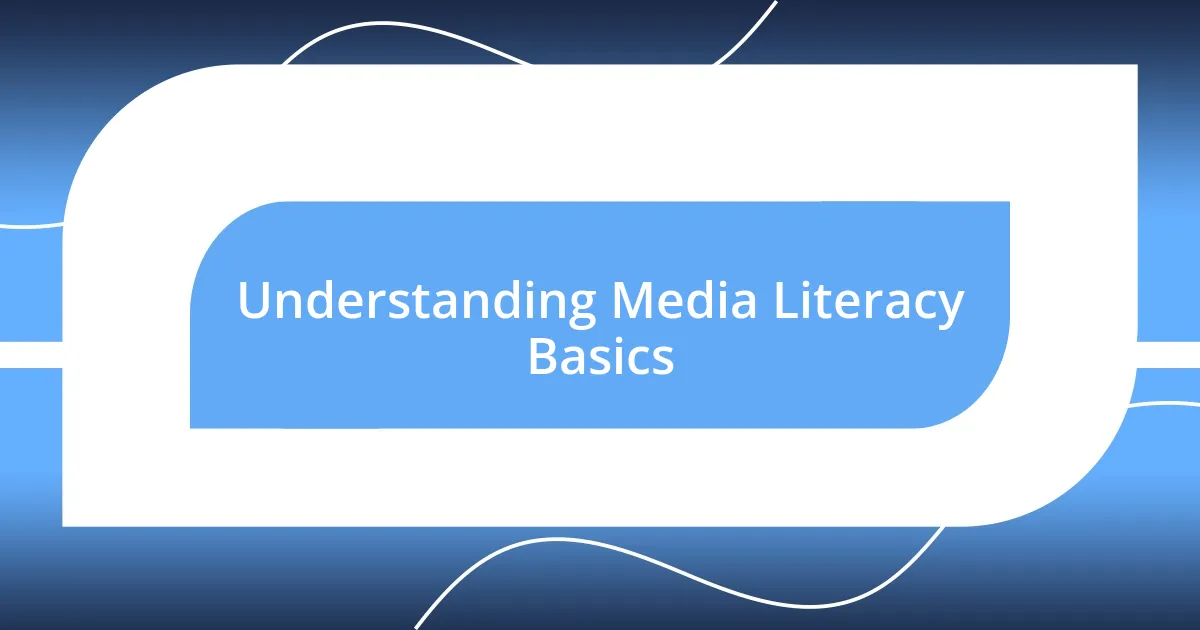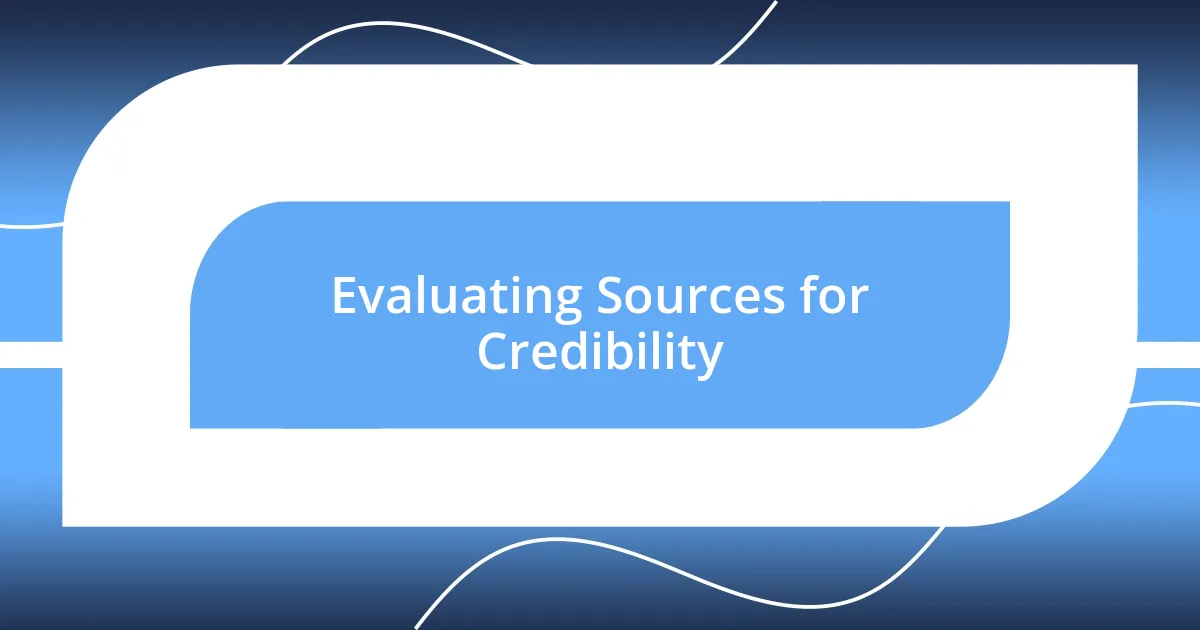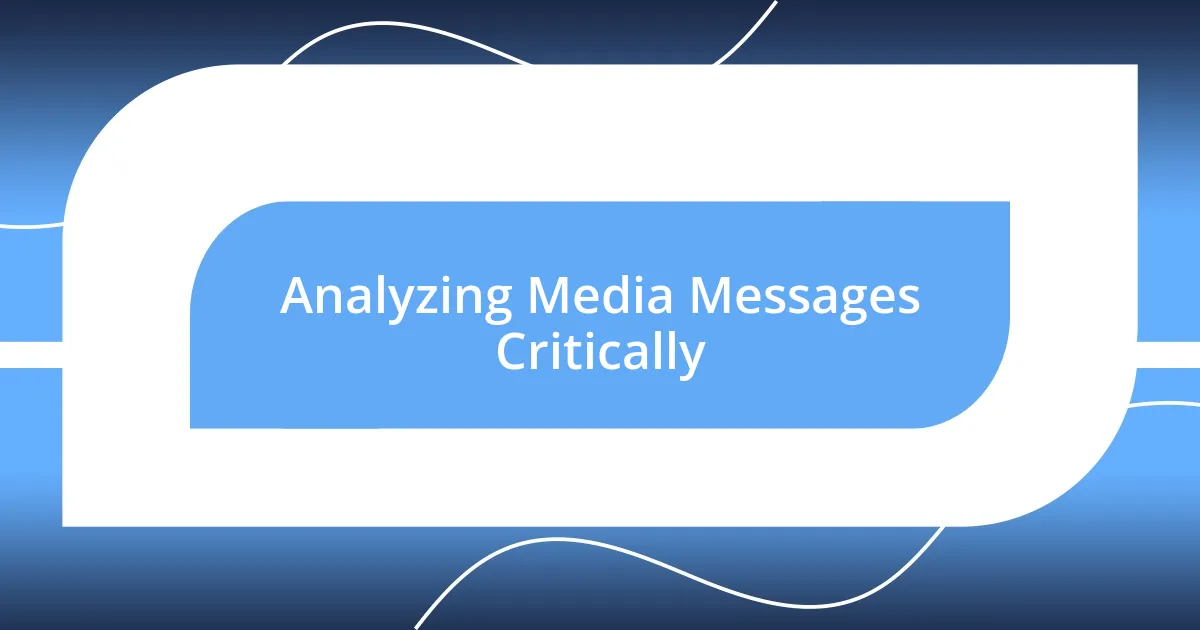Key takeaways:
- Media literacy is crucial for distinguishing between credible sources and misinformation, allowing for informed participation in discussions.
- Understanding techniques such as sensationalism, misleading statistics, and emotional appeals helps protect against manipulation.
- Developing effective media practices, like creating a consumption checklist and engaging in discussions, enhances critical thinking skills.
- Sharing knowledge about media literacy fosters understanding and encourages others to cultivate a critical mindset.

Understanding Media Literacy Basics
Media literacy is all about the ability to critically analyze and evaluate information we encounter daily. I remember the first time I stumbled upon a sensational news headline; I felt compelled to click it. But that moment also sparked a question: “What makes this credible?” It’s crucial to distinguish between what is fact and what is opinion, especially in today’s fast-paced digital world.
Understanding the basics of media literacy means recognizing that not all sources are created equal. Reflecting on my own experiences, I’ve sometimes shared articles that later turned out to be misleading. That taught me to assess the author, publication, and underlying agenda behind every piece of content. Have you ever wondered how frequently we share information without checking its validity?
At its core, media literacy empowers us to engage thoughtfully with the media we consume. When I take a moment to question who benefits from a narrative or what bias might be present, I realize I’m not just a passive consumer; I’m an informed participant in the conversation. Isn’t it liberating to think we can impact the dialogue around us by applying these basic principles?

Importance of Media Literacy Skills
Understanding media literacy isn’t just an academic exercise; it’s a life skill that enhances our ability to navigate a complex information landscape. I recall a time when I was misled by a viral post touting a miracle product. It felt like a punch to the gut when I later discovered it was filled with misinformation. This realization reinforced the importance of being skeptical and discerning. In today’s media-rich environment, media literacy skills enable us to:
- Differentiate between credible sources and unreliable ones.
- Recognize biases and agendas that may shape narratives.
- Engage in constructive dialogue based on accurate information.
- Protect ourselves from being manipulated by sensationalism.
Additionally, media literacy cultivates our critical thinking abilities, helping us make informed decisions. I often find myself pausing before sharing something on social media, recalling my earlier experiences. It’s more than just a habit; it’s a reflection of my commitment to fostering a more informed community. By honing these skills, we’re not only safeguarding our perspectives but also encouraging others to question and think critically. Engaging with media this way can transform the way we interact with the world, empowering us to participate meaningfully in discussions that matter.

Identifying Misinformation Techniques
Identifying misinformation techniques is essential for navigating today’s media landscape. One key technique I’ve observed is sensationalism, where headlines are designed to shock or provoke a strong reaction. I once clicked on a story that claimed to reveal “the truth behind a celebrity scandal,” only to find it filled with exaggerated claims. Looking back, I realize that a little skepticism could have saved me time and energy that I spent dissecting the story for accuracy.
Another common tactic is the use of misleading statistics or cherry-picked data to support shaky claims. I vividly recall encountering a viral infographic boasting staggering figures about health trends. Upon further investigation, I found that the data had been selectively presented, omitting crucial information that would alter the interpretation completely. This experience taught me to dig deeper and always question the context provided in statistics—what might be omitted could be just as critical as the numbers themselves.
It’s also vital to recognize emotional appeals in narratives. I remember reading a post about a local event that aimed to evoke indignation among readers. It was effective in stirring up feelings without presenting a balanced view of the situation. I’ve learned to consider how an article makes me feel and whether that feeling aligns with rational thinking or thorough reporting. By remaining aware of these techniques and reflecting on personal experiences, we can better protect ourselves from misinformation.
| Technique | Description |
|---|---|
| Sensationalism | Exaggerated headlines designed to provoke emotion. |
| Misleading Statistics | Use of selectively presented data to support claims. |
| Emotional Appeals | Narratives crafted to evoke strong feelings without balance. |

Evaluating Sources for Credibility
When evaluating sources for credibility, I find it essential to look beyond just the headlines. I remember reading an article purportedly from a reputable publication that turned out to be a satirical piece masquerading as genuine journalism. If I hadn’t checked the source, I might have ended up sharing that misinformation. This experience drives home the point that verifying the source isn’t just a precaution; it’s a necessity.
Another key aspect is assessing the author’s qualifications. I once stumbled across a blog written by someone presenting themselves as an expert in nutrition. However, a quick search revealed that their credentials were, quite frankly, unconvincing. It made me question how often we take someone’s word at face value. This realization emphasizes the importance of understanding the background and expertise of those sharing information, which can significantly impact our perception of their claims.
Lastly, checking the publication’s date is crucial. I once shared an interesting piece about technological advancements, only to later discover it was two years old. While the information was accurate at the time, the rapid pace of change in tech rendered it somewhat obsolete. Have you ever thought about the relevance of information in today’s fast-paced world? I’ve learned that a piece’s timeliness can be just as vital as its accuracy, reminding us that context matters immensely when evaluating credibility.

Analyzing Media Messages Critically
When I analyze media messages, I often start by peeling back layers to discern the intent behind them. For instance, I once encountered a video clip making bold claims about climate change, but it didn’t take long for me to notice how it selectively featured experts who echoed a particular viewpoint while disregarding others. This experience made me realize that scrutinizing who is included—and excluded—can significantly alter the narrative presented, leading me to dig deeper into diverse perspectives.
I’ve also noticed that the language used can be telling of the underlying message. A few months ago, I read several articles discussing economic policy, but the ones employing charged adjectives like “draconian” or “revolutionary” sparked my skepticism. Such polarizing language often indicates a slant designed to shape opinion rather than inform. It raised a question in my mind: Are these articles truly providing balanced information, or are they simply pushing a specific agenda? This inquiry often guides my approach to deconstructing messages, ensuring I hold each piece to a standard of objectivity.
Moreover, I practice dissecting visuals accompanying articles. I recall a beautifully crafted infographic claiming impressive benefits from a trendy diet. While it was visually stunning, I noticed it lacked adequate footnotes to justify its claims. This made me think: is a slick presentation enough to trust the information presented? Since then, I’ve learned to be harsher in my evaluating visuals, as they can sometimes conceal a lack of substance. Ultimately, critically analyzing media messages not only enriches my understanding but also cultivates a mindset of inquiry, which benefits me in today’s information-saturated world.

Developing Effective Media Practices

Developing Effective Media Practices
One powerful practice I’ve adopted is creating a media consumption checklist. I remember the chaos of misinformation during the pandemic, where every day brought a new wave of conflicting stories. To combat this, my checklist includes verifying the author’s credentials, examining the publication date, and cross-referencing with reputable sources. This simple yet effective strategy filters out noise and sharpens my focus on credible information. How often do you pause to consider your go-to sources?
In addition, engaging in discussions about media literacy has enriched my understanding. There was a time when I was hesitant to share my opinions for fear of backlash. However, joining a community of like-minded individuals allowed me to explore different viewpoints and refine my critical thinking skills. Hearing others’ experiences opened my eyes to fresh perspectives and taught me the value of respectful discourse. Have you ever found yourself learning more through conversations than through solitary learning? I can confidently say that I have.
Finally, I’ve learned the importance of staying updated on media literacy resources. I regularly seek out webinars or articles related to this topic, as the media landscape constantly evolves. Just last month, I attended an online workshop that introduced me to tools for fact-checking in real-time. It felt empowering to gain practical techniques that I could apply immediately. Have you considered how ongoing education can keep your media practices effective? For me, it’s clear that keeping my skills sharp is as crucial as critiquing the media itself.

Sharing Knowledge and Resources
Sharing knowledge about media literacy is like building a bridge to understanding. Recently, I joined a local discussion group focused on digital literacy, and the conversations we had were eye-opening. While sharing useful articles and resources, attendees brought in personal experiences that illuminated the pitfalls of misinformation. I found myself reflecting on how each person’s story further reinforced the value of collaborating and exchanging insights.
I also remember a time when I stumbled upon a valuable online resource for media literacy. It was a comprehensive guide outlining tools for evaluating news sources. I felt a rush of excitement—as someone always seeking to improve my skills, I shared this with friends and family. It sparked intense discussions at dinner, where everyone discovered new ways to process the media they consumed. Isn’t it fascinating how sharing resources can ignite curiosity and drive deeper conversations?
Another impactful moment for me was when I volunteered at a local school, teaching kids about discerning trustworthy sources. Witnessing their eagerness to learn and engage with media was inspiring. It reminded me that sharing knowledge isn’t just about giving information; it’s about cultivating a critical mindset in others. Reflecting on that experience makes me wonder: how often do we take the time to pass on our insights to those around us? For me, it’s become an essential part of my own growth journey.














